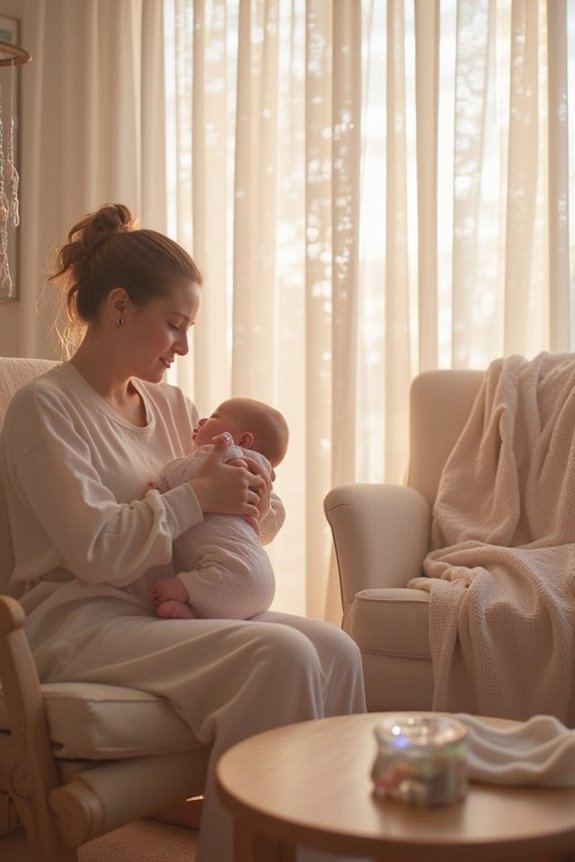We know baby hiccups can be troublesome, but here are five gentle methods to help soothe your little one. First, try effective burping techniques like holding your baby upright after feedings. Creating a calm feeding environment also reduces air intake, so keep noise levels low. Post-feeding, maintain an upright position for at least 30 minutes. Gentle motions, like rocking, can comfort them too. Lastly, monitor hiccup duration and symptoms; we’ll explore when it’s time to seek medical advice next.
Key Takeaways
- Hold your baby upright against your shoulder or in your lap to help release trapped air and alleviate hiccups.
- Apply gentle pressure while patting your baby’s back to encourage burping, reducing hiccup occurrences.
- Maintain a calm feeding environment with low noise and soft lighting to minimize air intake during feeding.
- Keep your baby upright for at least 30 minutes after feeding to reduce the risk of hiccups and spit-up.
- If hiccups persist beyond 5-10 minutes or cause discomfort, consult your pediatrician for further guidance.
Burping Techniques to Alleviate Hiccups
When it comes to helping our little ones with hiccups, using effective burping techniques can make a big difference. We should remember that burping helps release trapped air, which can ease discomfort and potentially reduce those pesky hiccups. Here are some effective burping positions to try:
- Against the Chest: Hold your baby upright against your shoulder.
- On the Lap: Sit them upright in your lap, supporting their head.
- On the Belly: Lay them on your lap, head higher than the chest.
As we pat their back using a cupped hand, let’s apply gentle pressure to make it more comfortable. Regular burping after feedings can really help keep hiccups at bay, so let’s stay consistent!
Creating a Calm Feeding Environment

Creating a calm feeding environment is essential for helping our little ones feed comfortably and reducing the chances of hiccups. By choosing the right feeding positions and minimizing distractions, we can create a soothing sensory environment. Here are some tips to help us achieve this:
- Paced feeding: Encourage slow, gentle feeding to reduce air intake.
- Consistent feeding position: Stick to a comfortable position that promotes relaxation.
- Calm setting: Keep noise levels low and lighting soft to foster peace.
- Timing awareness: Pay attention to your baby’s cues to avoid rushing.
Keeping Baby Upright After Feedings

To effectively manage baby hiccups, keeping our little ones upright after feedings is a crucial strategy. By maintaining a post feeding position for at least 30 minutes, we can reap several upright benefits. This helps minimize air intake, reducing the risk of hiccups and spit-up.
Here are some tips for achieving this:
- Hold baby upright: Position them against your shoulder or in a seated position.
- Burp frequently: This allows any trapped air to escape before hiccups start.
- Establish a routine: Consistently use this upright posture after each feeding for the best results.
Gentle Motion and Comforting Methods

Gentle motion and comforting methods can work wonders for soothing baby hiccups, and we’ve got several techniques to help you find what works best for your little one.
- Rocking Techniques: Gently rocking your baby, whether in your arms or a swing, can help them relax.
- Soothing Sounds: Using white noise or soft music can distract and calm them.
- Cradle Motion: Mimicking a cradle’s gentle sway is often effective.
- Skin-to-Skin Contact: This creates warmth and comfort, reducing stress.
- Gentle Touch: A soothing massage can relax their diaphragm.
These methods not only soothe hiccups but also promote a sense of security, helping your baby feel cherished and calm during these moments.
When to Seek Medical Help for Hiccups

While hiccups are usually harmless and common in babies, there are certain situations when we need to be vigilant and seek medical help. If our little one’s hiccups last longer than 5-10 minutes or seem to cause discomfort, it’s time to consult a pediatrician.
We should also consider a visit if hiccups disrupt sleep or behavior, or if they occur frequently with other symptoms, like:
- Difficulty breathing or changes in skin color
- Spitting up or forceful vomiting
- Irritability after feeding
- Poor weight gain
Persistent hiccups might signal underlying issues that require a medical evaluation. By staying aware of these hiccup triggers, we can ensure our babies remain healthy and happy.
Frequently Asked Questions
Can Hiccups Cause Long-Term Issues for My Baby?
Like a fleeting shadow, hiccups rarely haunt our little ones with long-term issues. It’s time to dispel those hiccup myths; they’re mostly harmless. Our baby’s health is usually just fine, so let’s breathe easy together.
Are Hiccups a Sign of a Serious Medical Condition?
We understand your concern about hiccups possibly signaling serious medical conditions. While many hiccup causes are benign, persistent ones warrant a medical evaluation to rule out underlying issues. Trust your instincts and seek guidance if needed.
How Often Should I Expect My Baby to Have Hiccups?
Like a rhythmic lullaby, baby hiccup frequency varies. We can expect our little ones to hiccup often, sometimes several times a day. It’s just one of those common baby behaviors that usually brings little concern.
Is It Normal for Hiccups to Wake My Baby?
It’s not unusual for hiccups to wake our baby, but they typically won’t disrupt sleep often. We should monitor hiccup frequency and comfort, ensuring our little one stays peaceful during those precious sleep moments.
Can Certain Foods Trigger More Hiccups in Babies?
We understand your concern about whether certain foods trigger more hiccups in babies. While food sensitivities can play a role, it’s often our feeding techniques that matter most in minimizing hiccup occurrences. Let’s explore this together.





